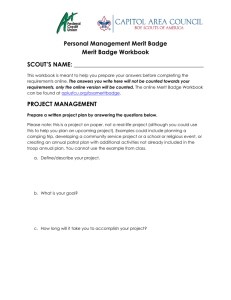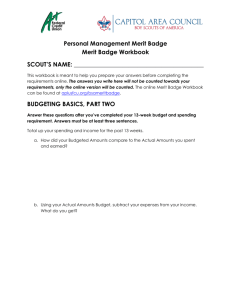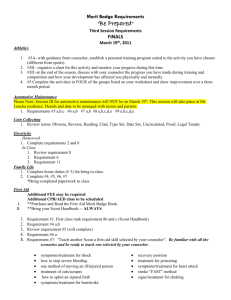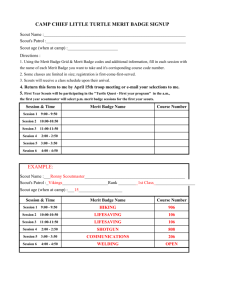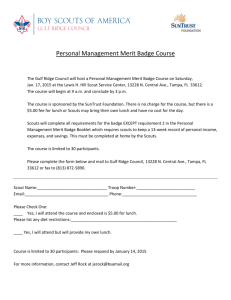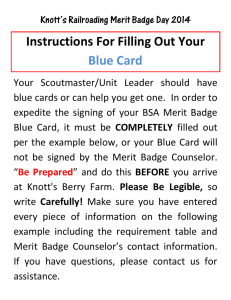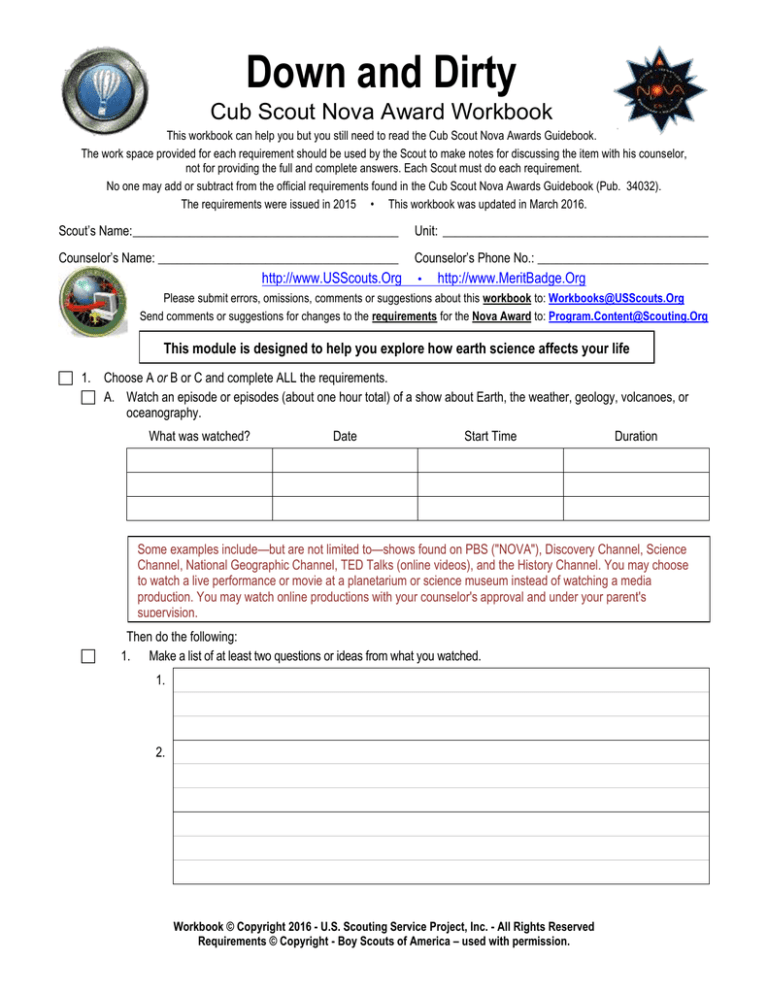
Down and Dirty
Cub Scout Nova Award Workbook
This workbook can help you but you still need to read the Cub Scout Nova Awards Guidebook.
The work space provided for each requirement should be used by the Scout to make notes for discussing the item with his counselor,
not for providing the full and complete answers. Each Scout must do each requirement.
No one may add or subtract from the official requirements found in the Cub Scout Nova Awards Guidebook (Pub. 34032).
The requirements were issued in 2015 • This workbook was updated in March 2016.
Scout’s Name:__________________________________________
Unit: __________________________________________
Counselor’s Name: ______________________________________
Counselor’s Phone No.: ___________________________
http://www.USScouts.Org
•
http://www.MeritBadge.Org
Please submit errors, omissions, comments or suggestions about this workbook to: Workbooks@USScouts.Org
Send comments or suggestions for changes to the requirements for the Nova Award to: Program.Content@Scouting.Org
This module is designed to help you explore how earth science affects your life
each day
1. Choose A or B or C and complete ALL the requirements.
A. Watch an episode or episodes (about one hour total) of a show about Earth, the weather, geology, volcanoes, or
oceanography.
What was watched?
Date
Start Time
Duration
Some examples include—but are not limited to—shows found on PBS ("NOVA"), Discovery Channel, Science
Channel, National Geographic Channel, TED Talks (online videos), and the History Channel. You may choose
to watch a live performance or movie at a planetarium or science museum instead of watching a media
production. You may watch online productions with your counselor's approval and under your parent's
supervision.
Then do the following:
1. Make a list of at least two questions or ideas from what you watched.
1.
2.
Workbook © Copyright 2016 - U.S. Scouting Service Project, Inc. - All Rights Reserved
Requirements © Copyright - Boy Scouts of America – used with permission.
Down and Dirty
2.
Scout's Name: ________________________
Discuss two of the questions or ideas with your counselor.
1.
2.
B. Read (about one hour total) about Earth, the weather, geology, volcanoes, or oceanography.
What was read?
Date
Start Time
Duration
Books on many topics may be found at your local library. Examples of magazines include but are not
limited to Odyssey, KIDS DISCOVER, National Geographic Kids, Highlights, and OWL or owlkids.com.
Then do the following:
1. Make a list of at least two questions or ideas from what you read.
1.
2.
Down and Dirty – Nova Award Workbook
Page 2 of 19
Down and Dirty
2.
Scout's Name: ________________________
Discuss two of the questions or ideas with your counselor.
1.
2.
C
Do a combination of reading and watching (about one hour total) about Earth, the weather, geology, volcanoes, or
oceanography.
What was watched or read?
Date
Start Time
Duration
Then do the following:
1. Make a list of at least two questions or ideas from what you read and watched.
1.
2.
Down and Dirty – Nova Award Workbook
Page 3 of 19
Down and Dirty
2.
Scout's Name: ________________________
Discuss two of the questions or ideas with your counselor.
1.
2.
2. Complete ONE adventure from the following list. (Choose one that you have not already earned.) Discuss with your
counselor what kind of science, technology, engineering, or math was used in the adventure.
Wolf Cub Scouts
Bear Cub Scouts
Webelos Scouts
Collections and Hobbies
Critter Care
Adventures in Science
Digging in the Past
Super Science
Earth Rocks!
Grow Something
Down and Dirty – Nova Award Workbook
Page 4 of 19
Down and Dirty
Scout's Name: ________________________
3. Investigate: Choose A or B or C or D and complete ALL the requirements
A. Volcanoes erupt
1. How are volcanoes formed?
2. What is the difference between lava and magma?
3. How does a volcano both build and destroy land?
4. Build or draw a volcano model. If you build a working model, make sure you follow all safety precautions
including wearing protective glasses for your volcano’s eruption. If you draw a volcano, be sure to draw a cross
section and explain the characteristics of different types of volcanoes.
Down and Dirty – Nova Award Workbook
Page 5 of 19
Down and Dirty
Scout's Name: ________________________
5. Share your model and what you have learned with your counselor.
B. Rock on.
1. What minerals are common in your state? How they are used.
Mineral
Used
Make a collection of three to five common minerals and explain
Mineral
Explanation
1.
2.
3.
4.
5.
2. Are these minerals found in sedimentary, igneous, or metamorphic rocks?
Mineral
Type of rock
1.
2.
3.
4.
5.
Down and Dirty – Nova Award Workbook
Page 6 of 19
Down and Dirty
Scout's Name: ________________________
3. Explain or demonstrate the difference in formation of the three major types of rocks.
Sedimentary
Igneous
Metamorphic
Which types of rocks are common in your area?
4. Share your collection and what you have learned with your counselor.
C. Weather changes our world
1. Make three weather instruments out of materials around your home. (Examples include a rain gauge, weather
vane, barometer, anemometer, and weather journal.)
1.
2.
3.
Use these and another method that is readily available (i.e., thermometer, eyes, older person’s joints, etc.) for a
total of four methods to monitor and predict the weather for one week. Keep a log of your findings.
(A sample page for recording the predictions and results may be found at the end of this workbook.)
Which instrument provided the most accurate information?
Down and Dirty – Nova Award Workbook
Page 7 of 19
Down and Dirty
Scout's Name: ________________________
2. Keep a weather journal for a week. Include your predictions and the predictions of a local meteorologist.
(A sample Journal page for recording the predictions and results may be found at the end of this workbook.)
Do your predictions match those of the local meteorologist?
Do your predictions match the weather that occurred?
How can the predictions become more accurate?
3. Discuss your work with your counselor.
D. Animal habitats: Choose TWO of the following animal habitats and complete the activity and questions. At least one
habitat should be close to your home (within 50 miles). Visit at least one of the habitats. Once you have completed
the activity and questions, discuss the habitats and the activities with your counselor:
1. Prairie
Draw or model a food web with at least five consumers and two producers that live in the prairie habitat.
What is the difference between consumers and producers? Predators and prey?
Down and Dirty – Nova Award Workbook
Page 8 of 19
Down and Dirty
Scout's Name: ________________________
What would happen if one of the animals in the food web disappeared?
2. Temperate forest
Research the two main categories of trees in the temperate forest (coniferous and deciduous).
Why are their leaves different?
How are their seeds different?
Put a twig from a coniferous tree (cone-bearing tree with needles) in a cup of water and tightly fasten a clear
plastic bag around the needles. Put a twig from a deciduous tree (leafy tree that loses its leaves in the fall) in a
cup of water and tightly fasten a clear plastic bag around the leaves. Observe what happens and draw pictures
of your observations.
Down and Dirty – Nova Award Workbook
Page 9 of 19
Down and Dirty
Scout's Name: ________________________
Think of an explanation for what occurred and discuss your explanation with your counselor
3. Aquatic ecosystem
With a parent’s permission and guidance, visit an aquatic habitat near your home. Examples include a stream,
river, lake, pond, ocean, and wetland (a marsh or swamp).
Draw or photograph the area.
What are the most common types of plants growing there?
What animals did you see?
Down and Dirty – Nova Award Workbook
Page 10 of 19
Down and Dirty
Scout's Name: ________________________
Did you see, hear, or smell any evidence of other animals? (Your evidence might include things like bird calls,
splashes of fish or frogs jumping, tracks, feathers, or bones.)
How do aquatic ecosystems affect your life?
How have humans affected the ecosystem? (Look for signs of humans such as trash and bridges or walkways.)
How do you think humans have affected the ecosystem in ways you cannot see? (Think about fertilizer and
pesticides washing off your lawn and flowing into a stream.
How would this affect creatures that live in the water?)
Down and Dirty – Nova Award Workbook
Page 11 of 19
Down and Dirty
Scout's Name: ________________________
What can you do to improve the quality of the ecosystem?
4. Temperate or subtropical rain forest
Describe the three main levels of the rain forest (canopy, understory, and forest floor).
Make a drawing or model showing examples of animals and plants that live at each level.
Choose an animal or plant from each level and explain how it is adapted to its particular place in the rain forest.
Down and Dirty – Nova Award Workbook
Page 12 of 19
Down and Dirty
Scout's Name: ________________________
5. Desert
Choose a desert animal or plant. ______________________________________________________________
Make a model of it, draw it, or describe it.
Explain how it is particularly well adapted to survive in a place where there is very little water.
How would the desert be different if this plant or animal were not there?
6. Polar ice
Research an animal that can be found in the polar ice habitat. _______________________________________
Down and Dirty – Nova Award Workbook
Page 13 of 19
Down and Dirty
Scout's Name: ________________________
Draw or make a model of the animal
and name three characteristics that make it well adapted for life in the very cold and snowy environment.
1.
2.
3.
7. Tide pools
Explain how a tide pool is formed and describe several animals that are found in tide pools.
Make a model or draw a diagram of a tide pool at a high intertidal zone and a low intertidal zone.
Include animals found in tide pools and explain how they adapt to their constantly changing environment.
Down and Dirty – Nova Award Workbook
Page 14 of 19
Down and Dirty
Scout's Name: ________________________
4. Visit. Choose A or B and complete ALL the requirements.
A. Visit a place where earth science is being done, used, explained, or investigated, such as one of the following: cave,
quarry or mine, geology museum or the gem or geology section of a museum, gem and mineral show, university
geology department, TV or radio station meteorology department, weather station, volcano or volcano research
station, or any other location where earth science is being done, used, explained, or investigated.
1. During your visit, talk to someone in charge about how people at the site use or investigate a particular area of
science. How could this investigation make the world better?
2. Discuss with your counselor the science being done, used, explained, or investigated at the place you visited.
B. Explore a career associated with earth science.
Find out what subjects you would need to study as you get older.
What kind of education would you need in the future to help explore Earth?
Down and Dirty – Nova Award Workbook
Page 15 of 19
Down and Dirty
Scout's Name: ________________________
What types of people other than geologists explore Earth?
Discuss with your counselor what is needed to have a career in earth science.
Down and Dirty – Nova Award Workbook
Page 16 of 19
Down and Dirty
Date
Scout's Name: ________________________
Method Used
Rain Gauge
Weather Vane
Barometer
Anemometer
Journal
Weather Prediction Methods (Requirement 3C1)
Prediction
Actual Weather
Rain Gauge
Weather Vane
Barometer
Anemometer
Journal
Rain Gauge
Weather Vane
Barometer
Anemometer
Journal
Rain Gauge
Weather Vane
Barometer
Anemometer
Journal
Rain Gauge
Weather Vane
Barometer
Anemometer
Journal
Rain Gauge
Weather Vane
Barometer
Anemometer
Journal
Rain Gauge
Weather Vane
Barometer
Anemometer
Journal
Choose FOUR of the methods listed and one other (such as thermometer, eyes, older person’s joints, etc)
Down and Dirty – Nova Award Workbook
Page 17 of 19
Down and Dirty
Date
Scout's Name: ________________________
Sample Weather Journal (Requirement 3C2)
Your Prediction
Meteorologist’s Prediction
Down and Dirty – Nova Award Workbook
Actual Weather
Page 18 of 19
Important excerpts from the Guide To Advancement - 2015, No. 33088 (SKU-620573)
[1.0.0.0] — Introduction
The current edition of the Guide to Advancement is the official source for administering advancement in all Boy Scouts of America programs: Cub Scouting, Boy
Scouting, Varsity Scouting, Venturing, and Sea Scouts. It replaces any previous BSA advancement manuals and previous editions of the Guide to Advancement.
[Page 2, and 5.0.1.4] — Policy on Unauthorized Changes to Advancement Program
No council, committee, district, unit, or individual has the authority to add to, or subtract from, advancement requirements. There are limited exceptions
relating only to youth members with special needs. For details see section 10, “Advancement for Members With Special Needs”.
[Page 2] — The “Guide to Safe Scouting” Applies
Policies and procedures outlined in the Guide to Safe Scouting, No. 34416, apply to all BSA activities, including those related to advancement and Eagle Scout
service projects.
[7.0.3.1] — The Buddy System and Certifying Completion
A youth member must not meet one-on-one with an adult. Sessions with counselors must take place where others can view the interaction, or the Scout must have a
buddy: a friend, parent, guardian, brother, sister, or other relative—or better yet, another Scout working on the same badge—along with him attending the session. If
merit badge counseling or instruction includes any Web-based interaction, it must be conducted in accordance with the BSA Social Media Guidelines
(http://www.scouting.org/Marketing/Resources/SocialMedia). For example, always copy one or more authorized adults on email messages between counselors and
Scouts.
When the Scout meets with the counselor, he should bring any required projects. If these cannot be transported, he should present evidence, such as photographs or
adult verification. His unit leader, for example, might state that a satisfactory bridge or tower has been built for the Pioneering merit badge, or that meals were
prepared for Cooking. If there are questions that requirements were met, a counselor may confirm with adults involved. Once satisfied, the counselor signs the blue
card using the date upon which the Scout completed the requirements, or in the case of partials, initials the individual requirements passed.
Note that from time to time, it may be appropriate for a requirement that has been met for one badge to also count for another. See “Fulfilling More Than One
Requirement With a Single Activity,” 4.2.3.6.
[7.0.3.2] — Group Instruction
It is acceptable—and sometimes desirable—for merit badges to be taught in group settings. This often occurs at camp and merit badge midways, fairs, clinics, or
similar events. Interactive group discussions can support learning. The method can also be attractive to “guest experts” assisting registered and approved
counselors. Slide shows, skits, demonstrations, panels, and various other techniques can also be employed, but as any teacher can attest, not everyone will learn all
the material.
There must be attention to each individual’s projects and his fulfillment of all requirements. We must know that every Scout —actually and personally— completed
them. If, for example, a requirement uses words like “show,” “demonstrate,” or “discuss,” then every Scout must do that. It is unacceptable to award badges on the
basis of sitting in classrooms watching demonstrations, or remaining silent during discussions.
It is sometimes reported that Scouts who have received merit badges through group instructional settings have not fulfilled all the requirements. To offer a quality
merit badge program, council and district advancement committees should ensure the following are in place for all group instructional events.
A culture is established for merit badge group instructional events that partial completions are acceptable expected results.
A guide or information sheet is distributed in advance of events that promotes the acceptability of partials, explains how merit badges can be finished after
events, lists merit badge prerequisites, and provides other helpful information that will establish realistic expectations for the number of merit badges that can be
earned at an event.
Merit badge counselors are known to be registered and approved.
Any guest experts or guest speakers, or others assisting who are not registered and approved as merit badge counselors, do not accept the responsibilities of,
or behave as, merit badge counselors, either at a group instructional event or at any other time. Their service is temporary, not ongoing.
Counselors agree to sign off only requirements that Scouts have actually and personally completed.
Counselors agree not to assume prerequisites have been completed without some level of evidence that the work has been done. Pictures and letters from
other merit badge counselors or unit leaders are the best form of prerequisite documentation when the actual work done cannot be brought to the camp or site
of the merit badge event.
There is a mechanism for unit leaders or others to report concerns to a council advancement committee on summer camp merit badge programs, group
instructional events, and any other merit badge counseling issues—especially in instances where it is believed BSA procedures are not followed. See
“Reporting Merit Badge Counseling Concerns,” 11.1.0.0.
There must be attention to each individual’s projects and his fulfillment of all requirements. We must know that every Scout—actually and personally—
completed them.
It is permissible for guest speakers, guest experts, or others who are not merit badge counselors to assist in the counseling process. Those providing such
assistance must be under the direction of a registered and approved counselor who is readily available onsite, and provides personal supervision to assure all
applicable BSA policies and procedures—including those related to BSA Youth Protection—are in place and followed.
[7.0.3.3] — Partial Completions
A Scout need not pass all the requirements of one merit badge with the same counselor. It may be that due to timing or location issues, etc., he must meet with a
different counselor to finish the badge. The Application for Merit Badge has a place to record what has been finished—a “partial.” In the center section on the reverse
of the blue card, the counselor initials for each requirement passed. In the case of a partial completion, the counselor does not retain his or her portion of the card. A
subsequent counselor may choose not to accept partial work, but this should be rare. A Scout, if he believes he is being treated unfairly, may work with his unit leader
to find another counselor. An example for the use of a signed partial would be to take it to camp as proof of prerequisites. Partials have no expiration except the
Scout’s 18th birthday. Units, districts, or councils shall not establish other expiration dates for partial merit badges.
[7.0.4.8] — Unofficial Worksheets and Learning Aids
Worksheets and other materials that may be of assistance in earning merit badges are available from a variety of places including unofficial sources on the Internet
and even troop libraries. Use of these aids is permissible as long as the materials can be correlated with the current requirements that Scouts must fulfill. Completing
“worksheets” may suffice where a requirement calls for something in writing, but this would not work for a requirement where the Scout must discuss, tell, show, or
demonstrate, etc. Note that Scouts shall not be required to use these learning aids in order to complete a merit badge.

